Deakin University: MAA703 - Cost Management Presentation Analysis
VerifiedAdded on 2022/10/12
|15
|1473
|392
Presentation
AI Summary
This presentation delves into the realm of cost management and cost behavior, crucial areas in contemporary accounting. It begins by highlighting the shift from traditional views to the recognition that managerial decisions, influenced by psychological biases and incentives, are the primary drivers of costs. The presentation explores the concept of cost behavior, differentiating between variable, fixed, and mixed costs, and emphasizing the importance of understanding these patterns for effective planning and control. It defines cost management as the process of planning and controlling business budgets, aiming to improve cost efficiency. The presentation then examines the determinants of cost management, including resource adjustment costs, managers' sales expectations, and managerial incentives. It concludes by discussing the role of cost managers in influencing cost behavior, its impact on financial ratios, and its broader implications for understanding managerial decisions and firm performance. The presentation leverages academic and professional literature to provide a comprehensive overview of the subject.
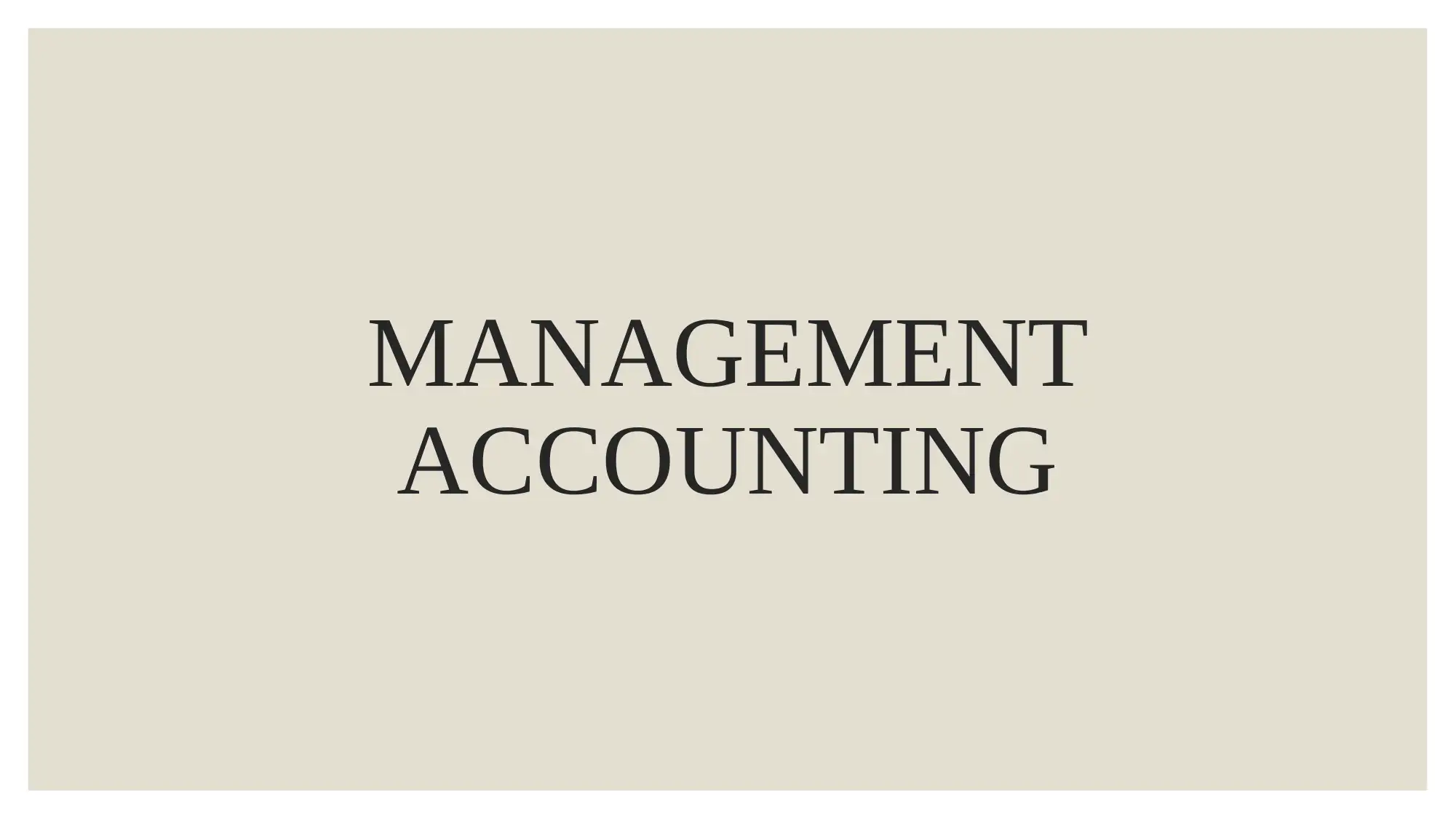
MANAGEMENT
ACCOUNTING
ACCOUNTING
Paraphrase This Document
Need a fresh take? Get an instant paraphrase of this document with our AI Paraphraser
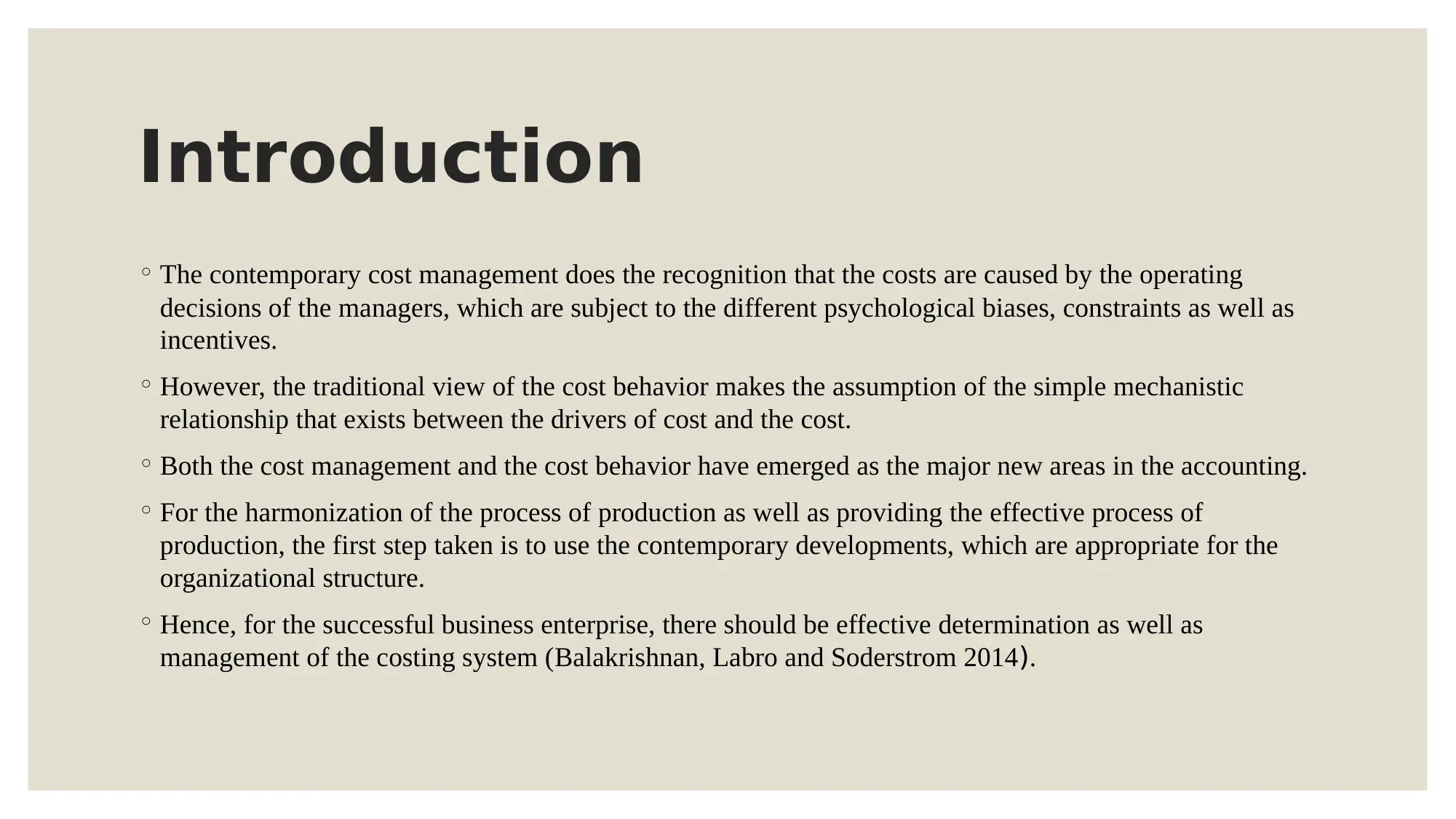
Introduction
◦ The contemporary cost management does the recognition that the costs are caused by the operating
decisions of the managers, which are subject to the different psychological biases, constraints as well as
incentives.
◦ However, the traditional view of the cost behavior makes the assumption of the simple mechanistic
relationship that exists between the drivers of cost and the cost.
◦ Both the cost management and the cost behavior have emerged as the major new areas in the accounting.
◦ For the harmonization of the process of production as well as providing the effective process of
production, the first step taken is to use the contemporary developments, which are appropriate for the
organizational structure.
◦ Hence, for the successful business enterprise, there should be effective determination as well as
management of the costing system (Balakrishnan, Labro and Soderstrom 2014).
◦ The contemporary cost management does the recognition that the costs are caused by the operating
decisions of the managers, which are subject to the different psychological biases, constraints as well as
incentives.
◦ However, the traditional view of the cost behavior makes the assumption of the simple mechanistic
relationship that exists between the drivers of cost and the cost.
◦ Both the cost management and the cost behavior have emerged as the major new areas in the accounting.
◦ For the harmonization of the process of production as well as providing the effective process of
production, the first step taken is to use the contemporary developments, which are appropriate for the
organizational structure.
◦ Hence, for the successful business enterprise, there should be effective determination as well as
management of the costing system (Balakrishnan, Labro and Soderstrom 2014).
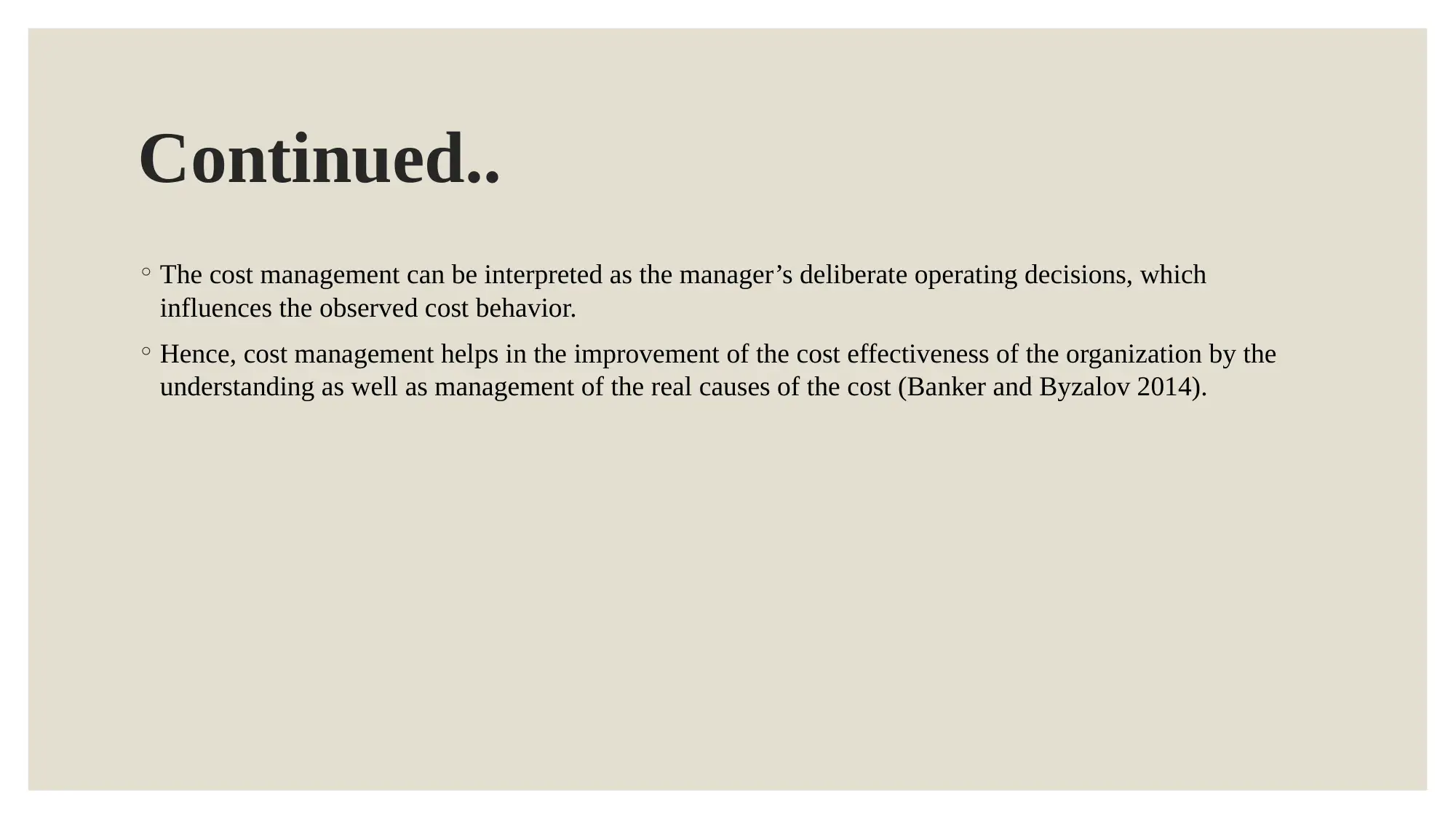
Continued..
◦ The cost management can be interpreted as the manager’s deliberate operating decisions, which
influences the observed cost behavior.
◦ Hence, cost management helps in the improvement of the cost effectiveness of the organization by the
understanding as well as management of the real causes of the cost (Banker and Byzalov 2014).
◦ The cost management can be interpreted as the manager’s deliberate operating decisions, which
influences the observed cost behavior.
◦ Hence, cost management helps in the improvement of the cost effectiveness of the organization by the
understanding as well as management of the real causes of the cost (Banker and Byzalov 2014).
⊘ This is a preview!⊘
Do you want full access?
Subscribe today to unlock all pages.

Trusted by 1+ million students worldwide
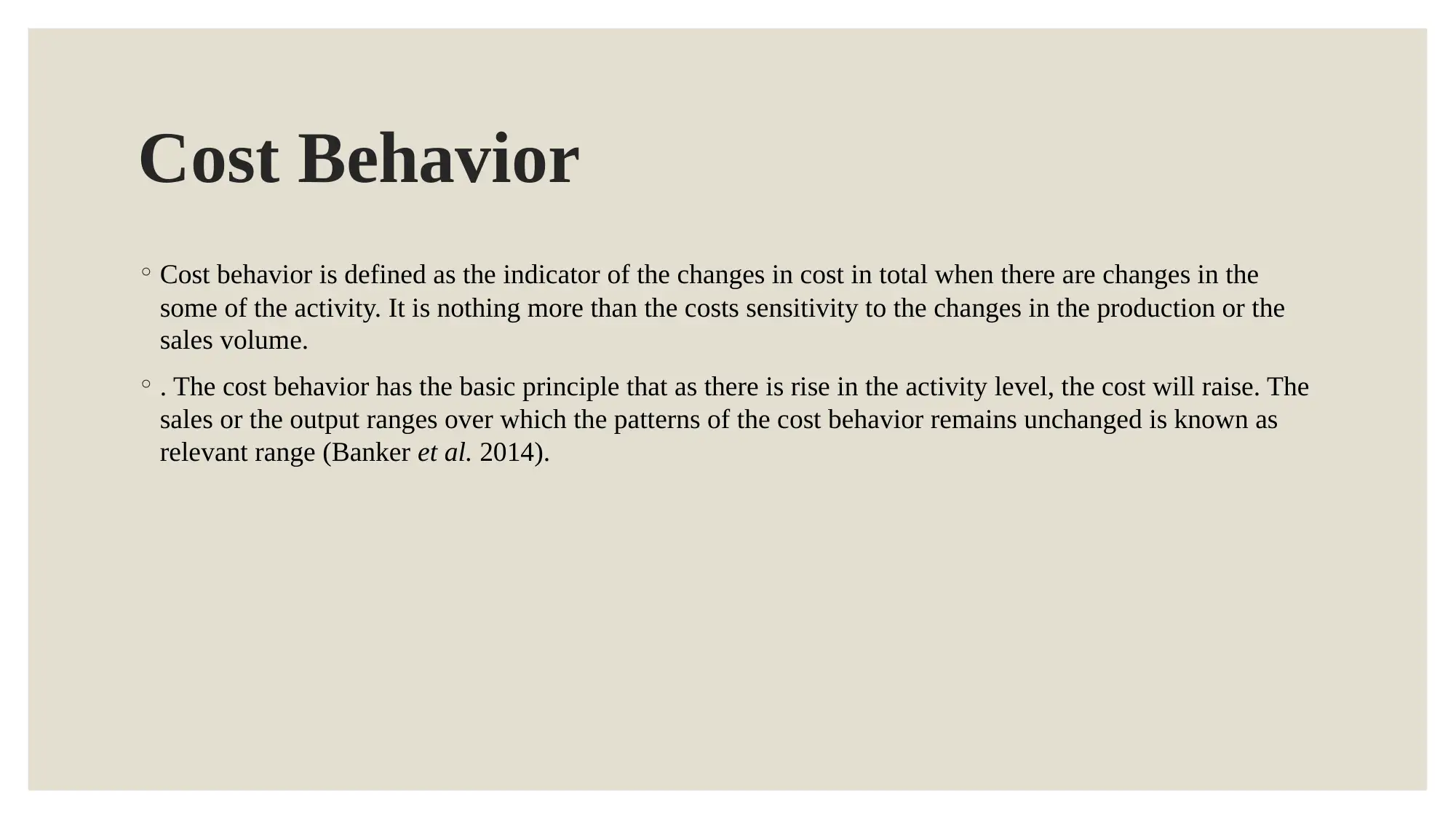
Cost Behavior
◦ Cost behavior is defined as the indicator of the changes in cost in total when there are changes in the
some of the activity. It is nothing more than the costs sensitivity to the changes in the production or the
sales volume.
◦ . The cost behavior has the basic principle that as there is rise in the activity level, the cost will raise. The
sales or the output ranges over which the patterns of the cost behavior remains unchanged is known as
relevant range (Banker et al. 2014).
◦ Cost behavior is defined as the indicator of the changes in cost in total when there are changes in the
some of the activity. It is nothing more than the costs sensitivity to the changes in the production or the
sales volume.
◦ . The cost behavior has the basic principle that as there is rise in the activity level, the cost will raise. The
sales or the output ranges over which the patterns of the cost behavior remains unchanged is known as
relevant range (Banker et al. 2014).
Paraphrase This Document
Need a fresh take? Get an instant paraphrase of this document with our AI Paraphraser
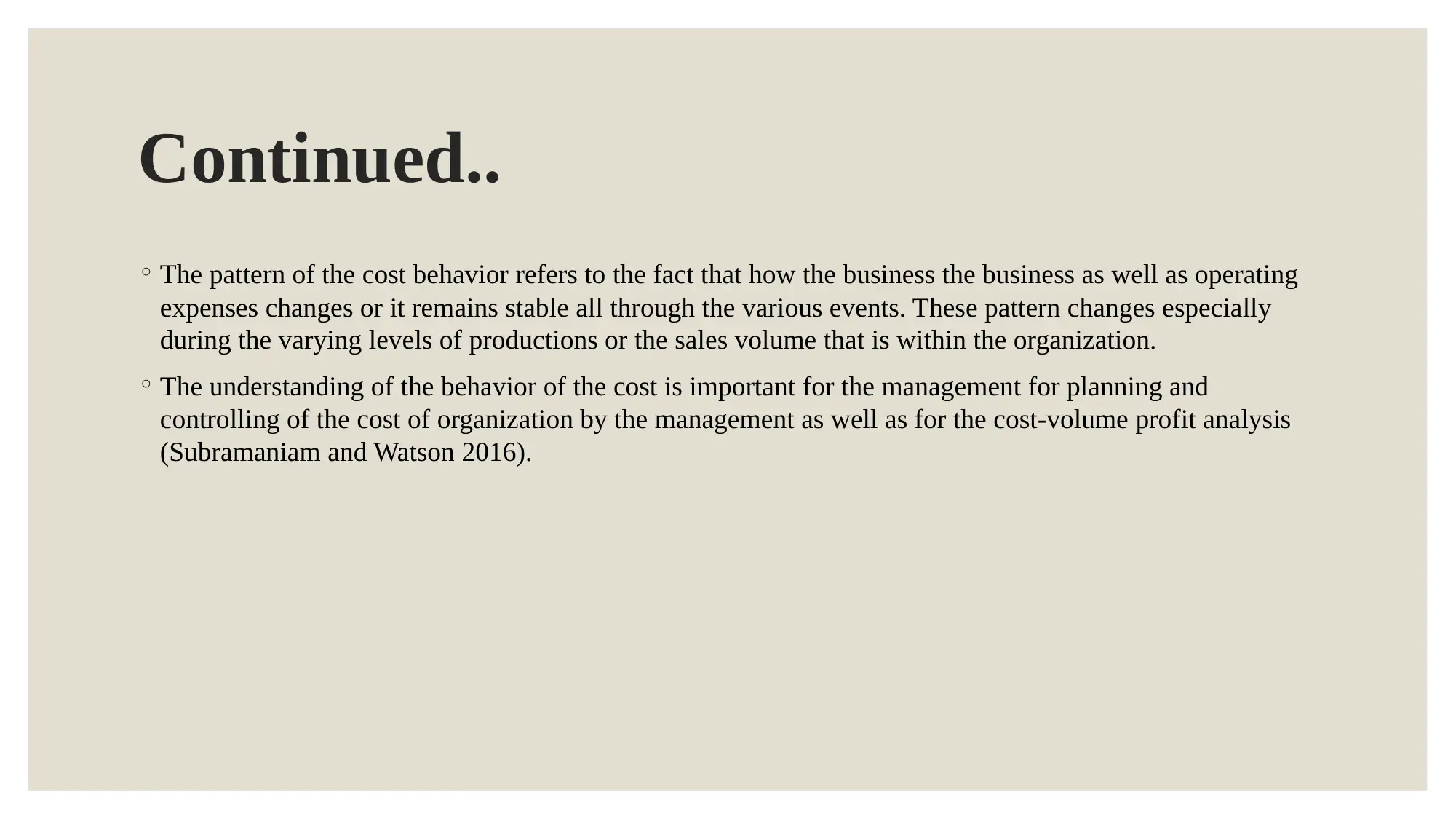
Continued..
◦ The pattern of the cost behavior refers to the fact that how the business the business as well as operating
expenses changes or it remains stable all through the various events. These pattern changes especially
during the varying levels of productions or the sales volume that is within the organization.
◦ The understanding of the behavior of the cost is important for the management for planning and
controlling of the cost of organization by the management as well as for the cost-volume profit analysis
(Subramaniam and Watson 2016).
◦ The pattern of the cost behavior refers to the fact that how the business the business as well as operating
expenses changes or it remains stable all through the various events. These pattern changes especially
during the varying levels of productions or the sales volume that is within the organization.
◦ The understanding of the behavior of the cost is important for the management for planning and
controlling of the cost of organization by the management as well as for the cost-volume profit analysis
(Subramaniam and Watson 2016).

Cost Behavior Types
◦ Variable Cost: The variable costs generally vary in total with the volume but it is constant per unit
within the relevant ranges. The overall amount of the variable cost will increase in the proportion to
increase in the activity. Moreover, the overall amount of the variable cost will decrease in the proportion
to decrease in the activity. This type of cost includes labor as well as materials. It also includes some of
the overheads costs such as supplies, indirect labor as well as some utilities (Banker et al. 2014).
◦ Variable Cost: The variable costs generally vary in total with the volume but it is constant per unit
within the relevant ranges. The overall amount of the variable cost will increase in the proportion to
increase in the activity. Moreover, the overall amount of the variable cost will decrease in the proportion
to decrease in the activity. This type of cost includes labor as well as materials. It also includes some of
the overheads costs such as supplies, indirect labor as well as some utilities (Banker et al. 2014).
⊘ This is a preview!⊘
Do you want full access?
Subscribe today to unlock all pages.

Trusted by 1+ million students worldwide
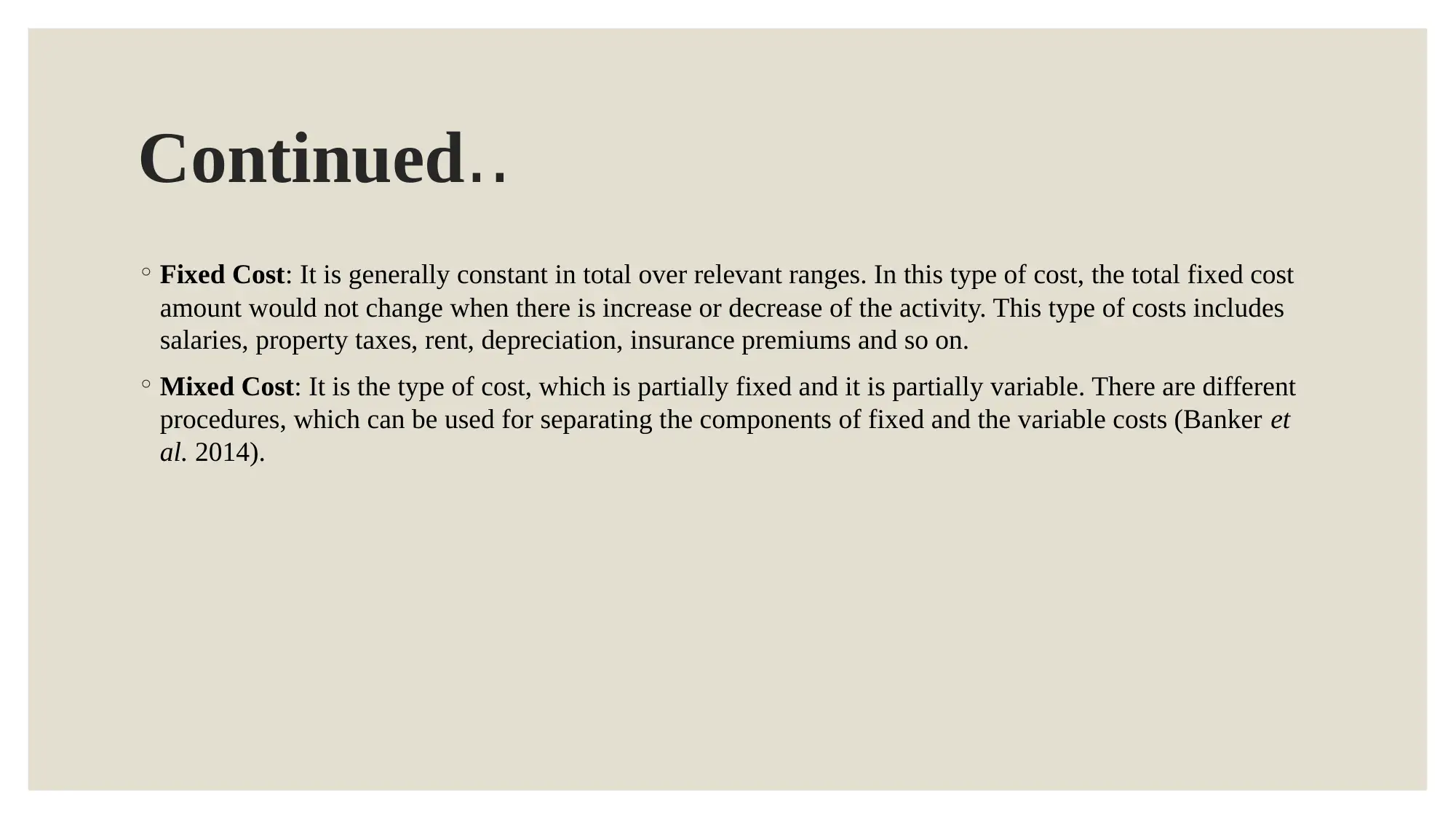
Continued..
◦ Fixed Cost: It is generally constant in total over relevant ranges. In this type of cost, the total fixed cost
amount would not change when there is increase or decrease of the activity. This type of costs includes
salaries, property taxes, rent, depreciation, insurance premiums and so on.
◦ Mixed Cost: It is the type of cost, which is partially fixed and it is partially variable. There are different
procedures, which can be used for separating the components of fixed and the variable costs (Banker et
al. 2014).
◦ Fixed Cost: It is generally constant in total over relevant ranges. In this type of cost, the total fixed cost
amount would not change when there is increase or decrease of the activity. This type of costs includes
salaries, property taxes, rent, depreciation, insurance premiums and so on.
◦ Mixed Cost: It is the type of cost, which is partially fixed and it is partially variable. There are different
procedures, which can be used for separating the components of fixed and the variable costs (Banker et
al. 2014).
Paraphrase This Document
Need a fresh take? Get an instant paraphrase of this document with our AI Paraphraser
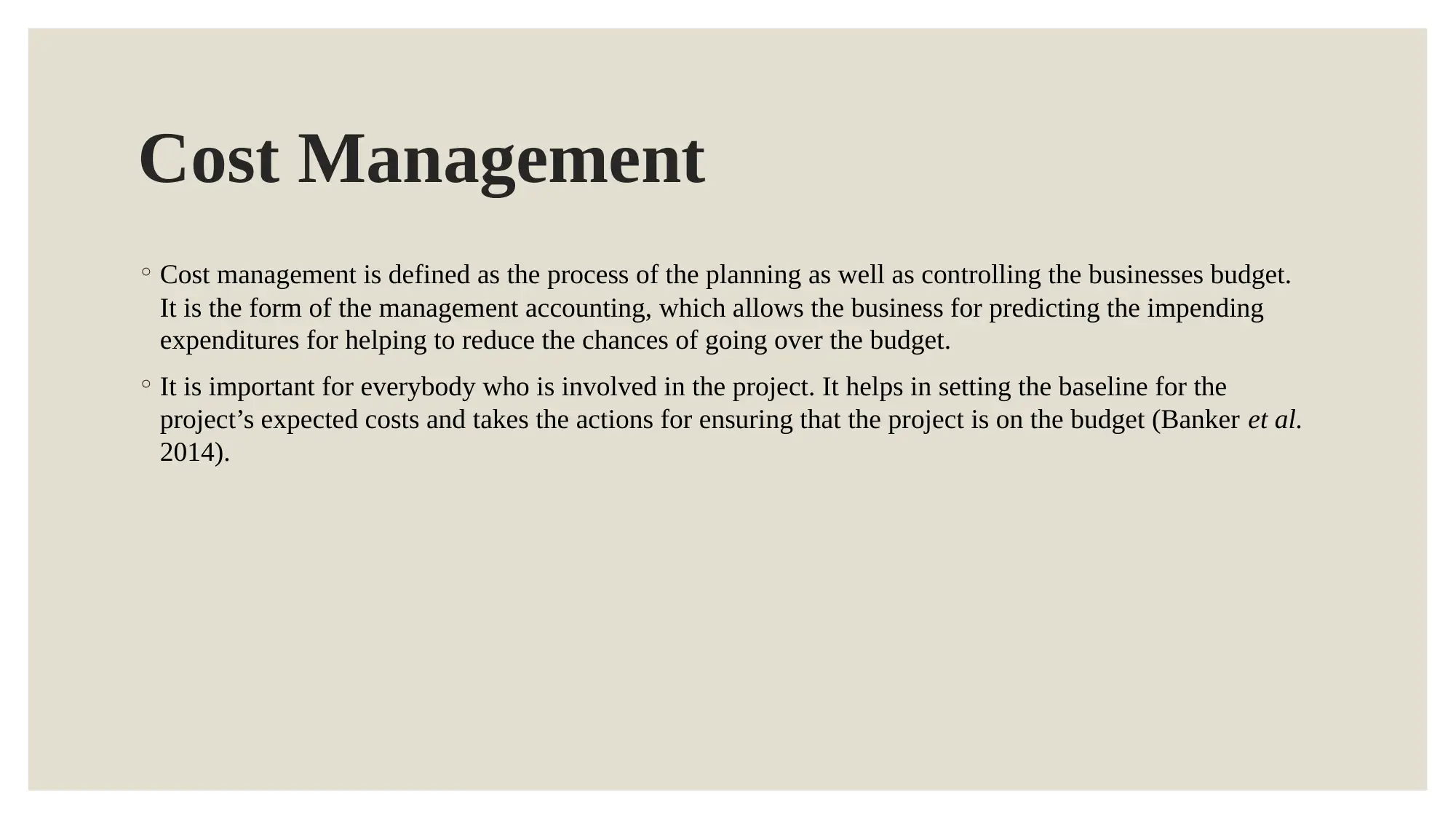
Cost Management
◦ Cost management is defined as the process of the planning as well as controlling the businesses budget.
It is the form of the management accounting, which allows the business for predicting the impending
expenditures for helping to reduce the chances of going over the budget.
◦ It is important for everybody who is involved in the project. It helps in setting the baseline for the
project’s expected costs and takes the actions for ensuring that the project is on the budget (Banker et al.
2014).
◦ Cost management is defined as the process of the planning as well as controlling the businesses budget.
It is the form of the management accounting, which allows the business for predicting the impending
expenditures for helping to reduce the chances of going over the budget.
◦ It is important for everybody who is involved in the project. It helps in setting the baseline for the
project’s expected costs and takes the actions for ensuring that the project is on the budget (Banker et al.
2014).
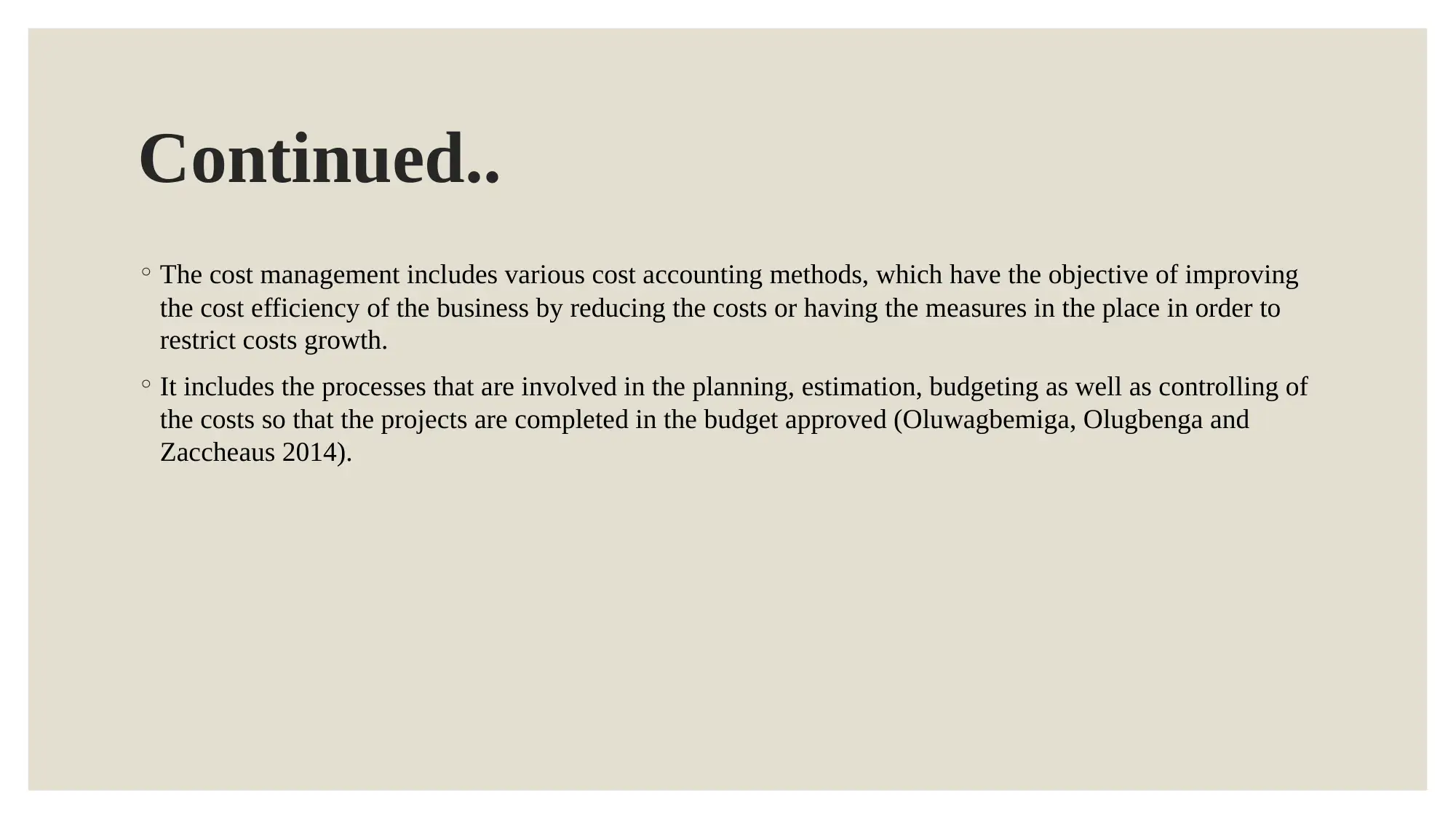
Continued..
◦ The cost management includes various cost accounting methods, which have the objective of improving
the cost efficiency of the business by reducing the costs or having the measures in the place in order to
restrict costs growth.
◦ It includes the processes that are involved in the planning, estimation, budgeting as well as controlling of
the costs so that the projects are completed in the budget approved (Oluwagbemiga, Olugbenga and
Zaccheaus 2014).
◦ The cost management includes various cost accounting methods, which have the objective of improving
the cost efficiency of the business by reducing the costs or having the measures in the place in order to
restrict costs growth.
◦ It includes the processes that are involved in the planning, estimation, budgeting as well as controlling of
the costs so that the projects are completed in the budget approved (Oluwagbemiga, Olugbenga and
Zaccheaus 2014).
⊘ This is a preview!⊘
Do you want full access?
Subscribe today to unlock all pages.

Trusted by 1+ million students worldwide
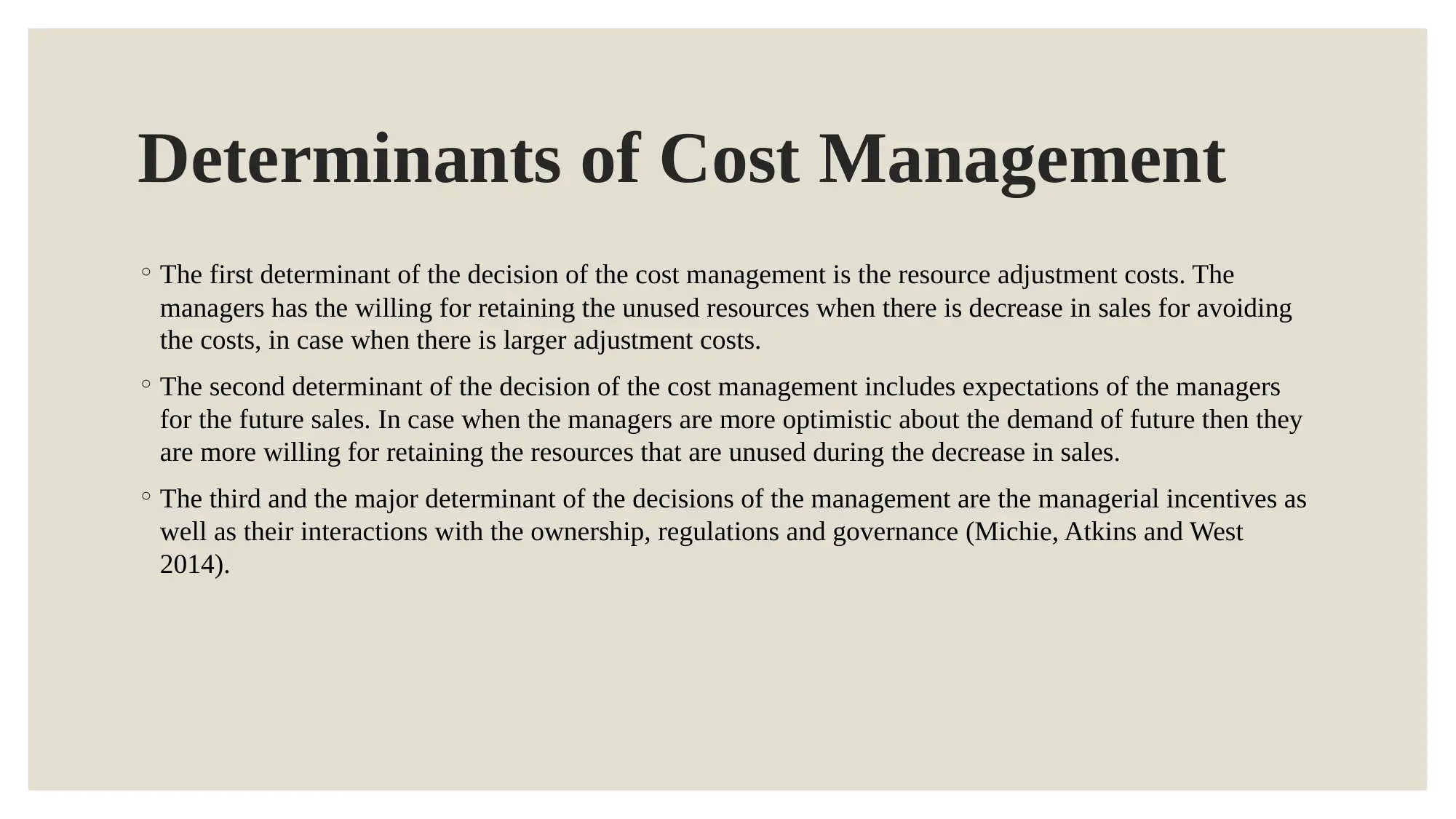
Determinants of Cost Management
◦ The first determinant of the decision of the cost management is the resource adjustment costs. The
managers has the willing for retaining the unused resources when there is decrease in sales for avoiding
the costs, in case when there is larger adjustment costs.
◦ The second determinant of the decision of the cost management includes expectations of the managers
for the future sales. In case when the managers are more optimistic about the demand of future then they
are more willing for retaining the resources that are unused during the decrease in sales.
◦ The third and the major determinant of the decisions of the management are the managerial incentives as
well as their interactions with the ownership, regulations and governance (Michie, Atkins and West
2014).
◦ The first determinant of the decision of the cost management is the resource adjustment costs. The
managers has the willing for retaining the unused resources when there is decrease in sales for avoiding
the costs, in case when there is larger adjustment costs.
◦ The second determinant of the decision of the cost management includes expectations of the managers
for the future sales. In case when the managers are more optimistic about the demand of future then they
are more willing for retaining the resources that are unused during the decrease in sales.
◦ The third and the major determinant of the decisions of the management are the managerial incentives as
well as their interactions with the ownership, regulations and governance (Michie, Atkins and West
2014).
Paraphrase This Document
Need a fresh take? Get an instant paraphrase of this document with our AI Paraphraser
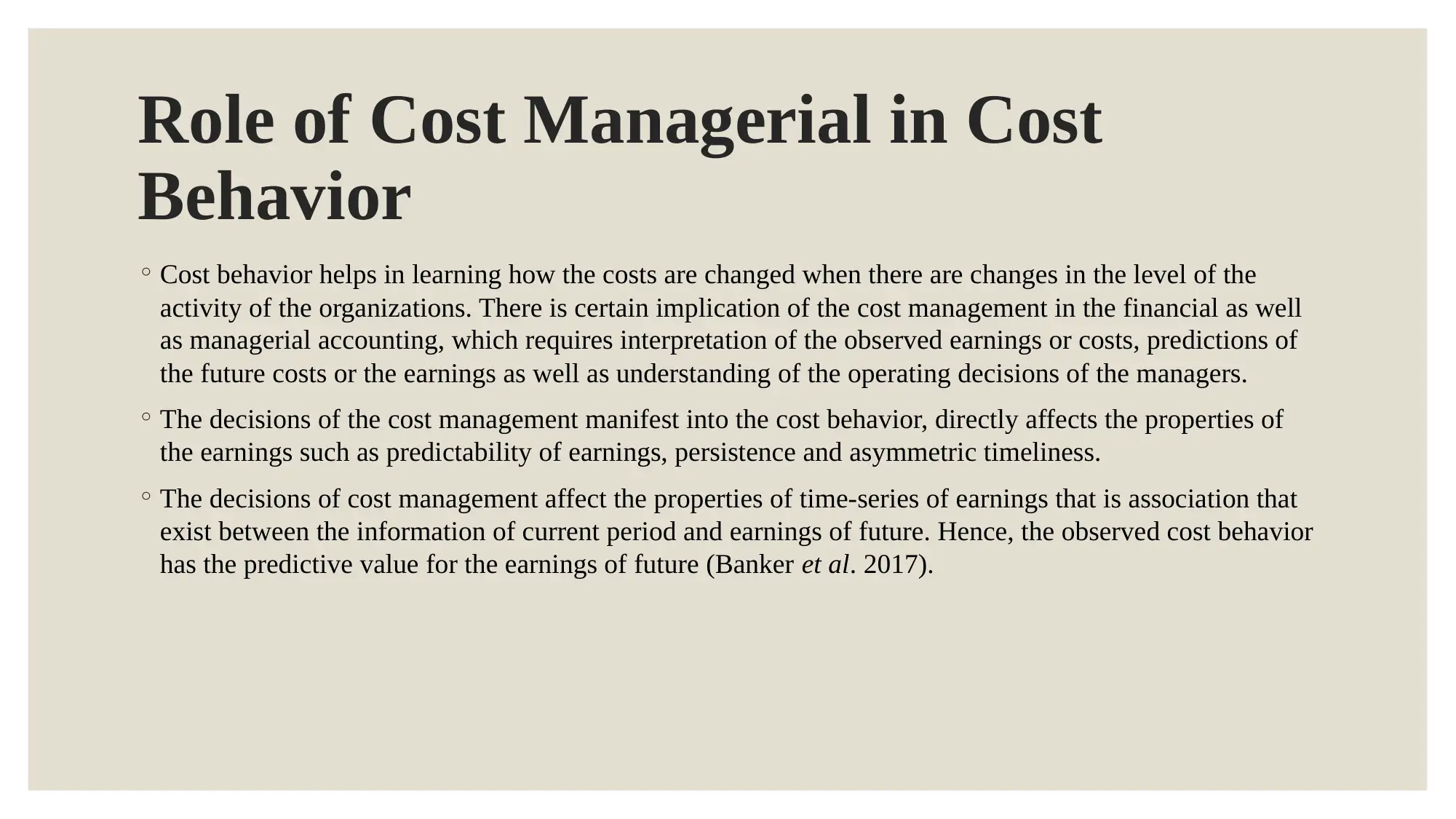
Role of Cost Managerial in Cost
Behavior
◦ Cost behavior helps in learning how the costs are changed when there are changes in the level of the
activity of the organizations. There is certain implication of the cost management in the financial as well
as managerial accounting, which requires interpretation of the observed earnings or costs, predictions of
the future costs or the earnings as well as understanding of the operating decisions of the managers.
◦ The decisions of the cost management manifest into the cost behavior, directly affects the properties of
the earnings such as predictability of earnings, persistence and asymmetric timeliness.
◦ The decisions of cost management affect the properties of time-series of earnings that is association that
exist between the information of current period and earnings of future. Hence, the observed cost behavior
has the predictive value for the earnings of future (Banker et al. 2017).
Behavior
◦ Cost behavior helps in learning how the costs are changed when there are changes in the level of the
activity of the organizations. There is certain implication of the cost management in the financial as well
as managerial accounting, which requires interpretation of the observed earnings or costs, predictions of
the future costs or the earnings as well as understanding of the operating decisions of the managers.
◦ The decisions of the cost management manifest into the cost behavior, directly affects the properties of
the earnings such as predictability of earnings, persistence and asymmetric timeliness.
◦ The decisions of cost management affect the properties of time-series of earnings that is association that
exist between the information of current period and earnings of future. Hence, the observed cost behavior
has the predictive value for the earnings of future (Banker et al. 2017).
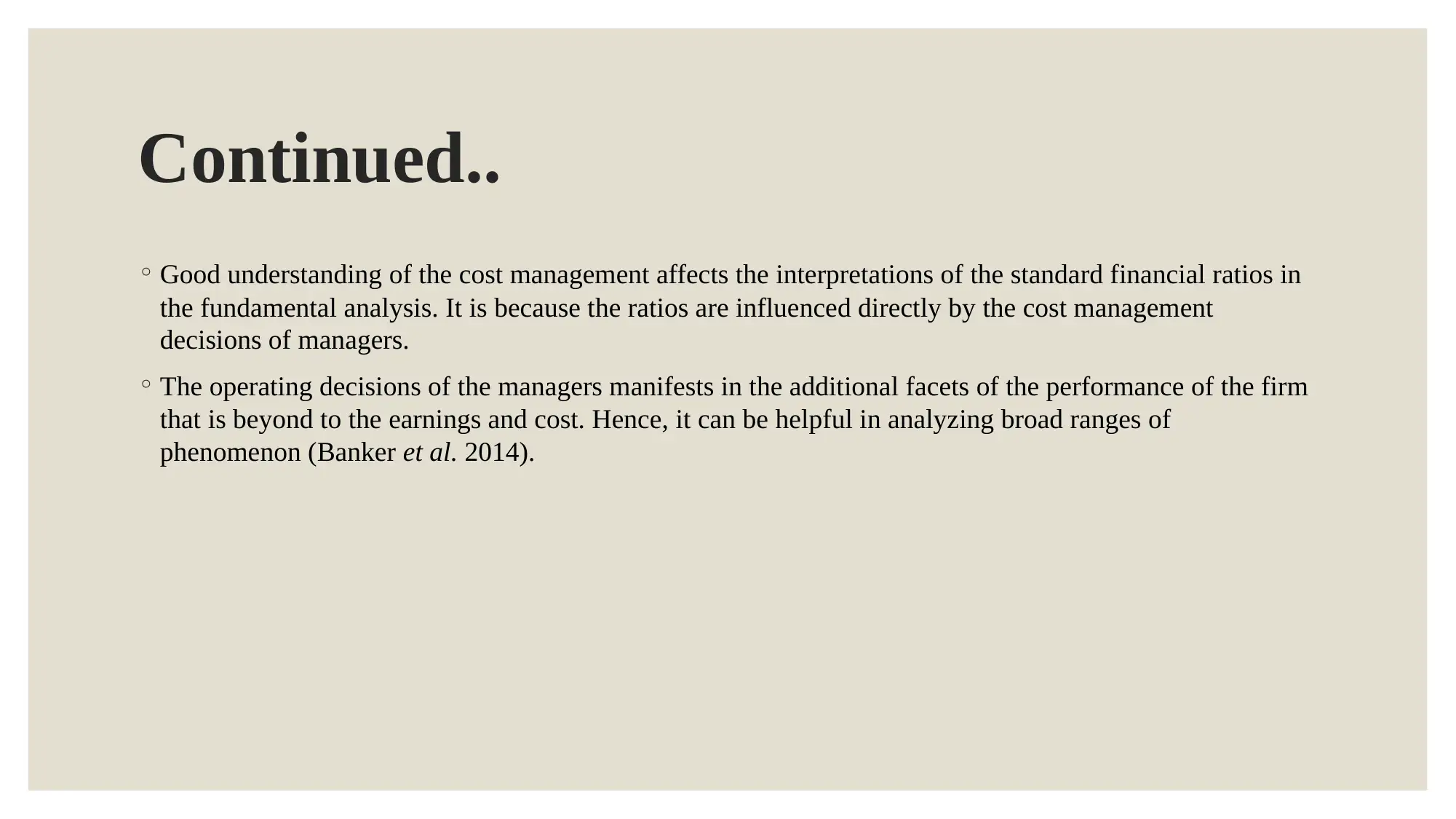
Continued..
◦ Good understanding of the cost management affects the interpretations of the standard financial ratios in
the fundamental analysis. It is because the ratios are influenced directly by the cost management
decisions of managers.
◦ The operating decisions of the managers manifests in the additional facets of the performance of the firm
that is beyond to the earnings and cost. Hence, it can be helpful in analyzing broad ranges of
phenomenon (Banker et al. 2014).
◦ Good understanding of the cost management affects the interpretations of the standard financial ratios in
the fundamental analysis. It is because the ratios are influenced directly by the cost management
decisions of managers.
◦ The operating decisions of the managers manifests in the additional facets of the performance of the firm
that is beyond to the earnings and cost. Hence, it can be helpful in analyzing broad ranges of
phenomenon (Banker et al. 2014).
⊘ This is a preview!⊘
Do you want full access?
Subscribe today to unlock all pages.

Trusted by 1+ million students worldwide
1 out of 15
Related Documents
Your All-in-One AI-Powered Toolkit for Academic Success.
+13062052269
info@desklib.com
Available 24*7 on WhatsApp / Email
![[object Object]](/_next/static/media/star-bottom.7253800d.svg)
Unlock your academic potential
Copyright © 2020–2025 A2Z Services. All Rights Reserved. Developed and managed by ZUCOL.




